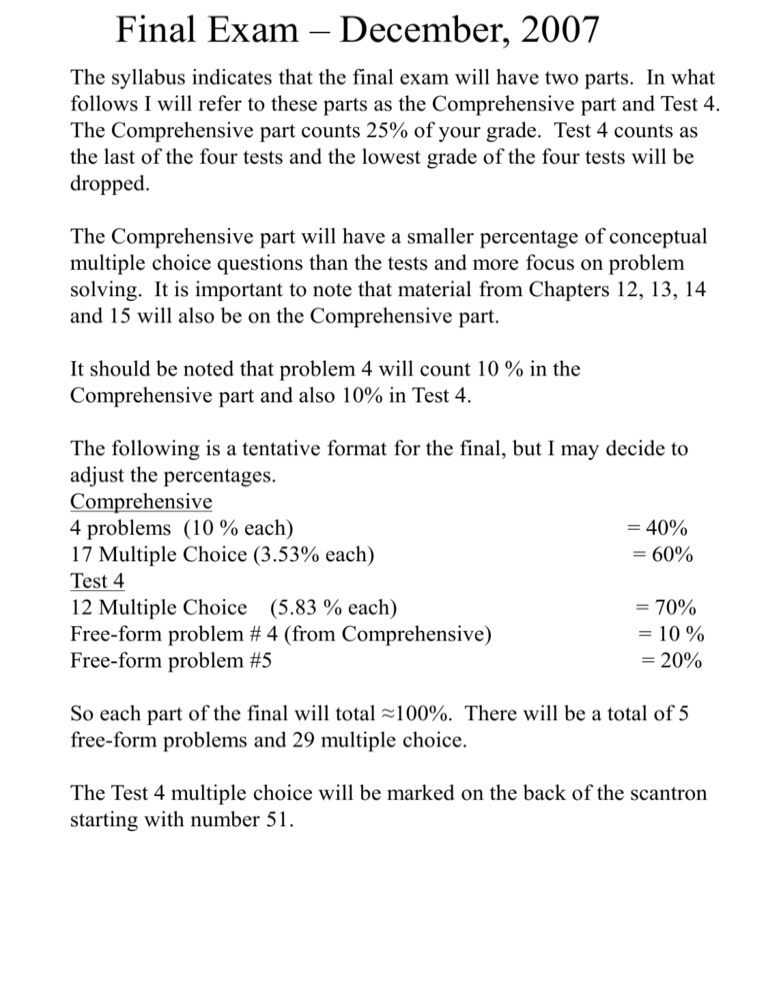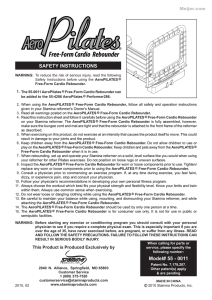Test 4
advertisement

Final Exam – December, 2007 The syllabus indicates that the final exam will have two parts. In what follows I will refer to these parts as the Comprehensive part and Test 4. The Comprehensive part counts 25% of your grade. Test 4 counts as the last of the four tests and the lowest grade of the four tests will be dropped. The Comprehensive part will have a smaller percentage of conceptual multiple choice questions than the tests and more focus on problem solving. It is important to note that material from Chapters 12, 13, 14 and 15 will also be on the Comprehensive part. It should be noted that problem 4 will count 10 % in the Comprehensive part and also 10% in Test 4. The following is a tentative format for the final, but I may decide to adjust the percentages. Comprehensive 4 problems (10 % each) = 40% 17 Multiple Choice (3.53% each) = 60% Test 4 12 Multiple Choice (5.83 % each) = 70% Free-form problem # 4 (from Comprehensive) = 10 % Free-form problem #5 = 20% So each part of the final will total ≈100%. There will be a total of 5 free-form problems and 29 multiple choice. The Test 4 multiple choice will be marked on the back of the scantron starting with number 51. The sections covered on the previous tests are listed on the website. The following sections will be included in the Comprehensive part of the final and also the Test 4 part of the final: Chapter 10: Sections 8, 9, 10 (Coverage will be discussed in last class) Chapter 12: Sections 1, 2, 3, 4, 5, 6, 7, 8 (Skip 9) Chapter 13: Sections 6, 7, 8, 9, 10, 11, (Skip 1, 2, 3, 4, 5, 12, 13, 14) Chapter 14: Sections 1, 2, 6, 7, 8 (Skip 3, 4, 5 ) Chapter 15: Sections 1, 2, 4, 5 (Skip 3, 6, 7, 8, 9, 10, 11, 12) Since no recitation problems were assigned for Ch 14, there will be no free-form problems from that chapter, however there could be numeric multiple choice questions from the equations for conduction and radiation. The equation list for the final is on the last page. Please bring the proper scantron (ParScore Test Form 8000 or Scantron 882-E). Students arriving late are not guaranteed extra time. Those arriving after students have started to leave will not be permitted to take the exam. You must bring a photo ID to the final– it will be checked as you leave. Final for 9:00 a.m. Lect: Monday, Dec. 17 7:30 a.m. 10:15 a.m. Final for 10:30 a.m. Lect: Wednesday, Dec 12 10:30 a.m. 1:15 p.m. You must take the exam in the section you are registered for because each class will have a different “curve”. Students who take the wrong exam will: •Receive an incomplete •Have a “penalty” subtracted from each part of the final •Have the grade for each part of final “adjusted” for differences in the difficulty level of the two exams. This could be positive or negative. The Comprehensive part of the exam will cover major topics from all 15 chapters. I said in class that there will be a problem on the Comprehensive part from the topics from each of the four tests, but I wish to retract this statement since Test 1 did not cover as much material as the other tests. The following minor topics will not be on the Comprehensive part of the final: satellite motion, universal gravitation, impulse, Archimedes principle, stability and balance, Pascal’s principle, and the pendulum. v v0 at 1 x x0 v0 t 2 v2 aR r a t2 v 2 v02 2 a ( x x0 ) F ma v F G v0 v 2 KE 2 0 t 2 I mr KErot 1 I 2 T 2 2 I sphere M R 2 5 f Q A1v1 A2v2 P1 1 1 v12 g y1 P2 v22 g y2 2 2 x2 A2 v f m k 1 1 T 2 I hoop M R 2 T 2 1 I cylinder M R 2 2 k m fn L g PV n R T KE Avogadros’ Number Na = 6.022 x 1023 particles/mol Acceleration due to gravity g = 9.8 m/s2 U 1 3 mv 2 k T 2 2 3 3 N k T n RT 2 2 Q e A (T14 T24 ) t Q T T2 kA 1 t l U Q W W P V Density of water = 1.0x103 kg /m3 1 liter = 1.00X10-3m3 I I0 v vobs f ' f snd vsnd vsource f BEAT f1 f 2 Ideal Gas Law Constant R = 8.314 J/mol K Acceleration due to gravity = 9.80 m/s2 2L n 10 log Stefan-Boltzmann Constant σ = 5.67x10-8 W / m2 K4 Area inside a circle = r2 nv 2L n Boltzman Constant k = 1.38 x 10-23 J/K Kelvin = 0C + 273 P 4 r 2 I Atmospheric Pressure = 1.01 x 105 Pa Intensity at threshold of hearing = 10-12 watts/m2 FT m/L v x A cos 2 f t 2 I I 0 0 1 2 kx 2 v v0 1 aR 2 r 2 FB F g V v0 2 A f A atan r I P PA g h Fout Aout Fin Ain F k x 0 v r r F Impulse F t p 1 2 mv 2 PE elastic 2 0 1 t2 2 m1m2 r2 PE grav mg y WNC K E1 PE1 K E 2 PE 2 0t P Fv p mv t W F d cos Ffr k FN 2 P W W P V e W Q QL Q H 1 L QH QH QH eideal 1 TL TH
